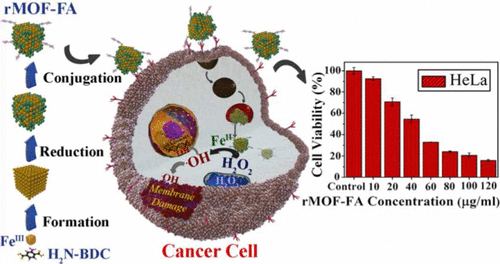当前位置:
X-MOL 学术
›
ACS Appl. Mater. Interfaces
›
论文详情
Our official English website, www.x-mol.net, welcomes your feedback! (Note: you will need to create a separate account there.)
MOF-Mediated Destruction of Cancer Using the Cell’s Own Hydrogen Peroxide
ACS Applied Materials & Interfaces ( IF 9.5 ) Pub Date : 2017-09-20 00:00:00 , DOI: 10.1021/acsami.7b07981 Hadi Ranji-Burachaloo 1 , Fatemeh Karimi 1 , Ke Xie 1 , Qiang Fu 1 , Paul A. Gurr 1 , Dave E. Dunstan 1 , Greg G. Qiao 1
ACS Applied Materials & Interfaces ( IF 9.5 ) Pub Date : 2017-09-20 00:00:00 , DOI: 10.1021/acsami.7b07981 Hadi Ranji-Burachaloo 1 , Fatemeh Karimi 1 , Ke Xie 1 , Qiang Fu 1 , Paul A. Gurr 1 , Dave E. Dunstan 1 , Greg G. Qiao 1
Affiliation

|
A novel reduced iron metal–organic framework nanoparticle with cytotoxicity specific to cancer cells is presented. This nanoparticle was prepared via a hydrothermal method, reduced using hydroquinone, and finally conjugated with folic acid (namely, rMOF-FA). The synthesized nanoparticle shows the controlled release of iron in an acidic ex-vivo environment. Iron present on the rMOF-FA and released into solution can react with high levels of hydrogen peroxide found specifically in cancer cells to increase the hydroxyl radical concentration. The hydroxyl radicals oxidize proteins, lipids, and/or DNA within the biological system to decrease cell viability. In vitro experiments demonstrate that this novel nanoparticle is cytotoxic to cancer cells (HeLa) through generation of OH• inside the cells. At low concentrations of rMOF-FA, the cancer cell viability decreases dramatically, with no obvious reduction of normal cell (NIH-3T3) viability. The calculated half-maximum inhibitory concentration value (IC50) was 43 μg/mL for HeLa cells, which was significantly higher than 105 μg/mL for NIH-3T3. This work thus demonstrates a new type of agent for controlled hydroxyl radical generation using the Fenton reaction to kill the tumor cells.
中文翻译:

MOF介导的细胞自身过氧化氢对癌症的破坏
提出了一种新型的还原铁金属有机骨架纳米粒子,具有对癌细胞特异的细胞毒性。通过水热法制备该纳米颗粒,使用对苯二酚还原,最后与叶酸(即rMOF-FA)结合。合成的纳米颗粒在酸性离体环境中显示出铁的受控释放。存在于rMOF-FA上并释放到溶液中的铁可与癌细胞中特有的高水平过氧化氢发生反应,从而增加羟自由基的浓度。羟基自由基会氧化生物系统中的蛋白质,脂质和/或DNA,从而降低细胞活力。体外实验表明,这种新型纳米颗粒通过生成OH •对癌细胞(HeLa)具有细胞毒性。里面的细胞。在低浓度的rMOF-FA下,癌细胞的生存能力急剧下降,而正常细胞(NIH-3T3)的生存能力没有明显降低。计算得出的HeLa细胞的半数最大抑制浓度值(IC 50)为43μg/ mL,明显高于NIH-3T3的105μg/ mL。因此,这项工作证明了使用芬顿反应杀死肿瘤细胞的新型可控羟基自由基产生剂。
更新日期:2017-09-20
中文翻译:

MOF介导的细胞自身过氧化氢对癌症的破坏
提出了一种新型的还原铁金属有机骨架纳米粒子,具有对癌细胞特异的细胞毒性。通过水热法制备该纳米颗粒,使用对苯二酚还原,最后与叶酸(即rMOF-FA)结合。合成的纳米颗粒在酸性离体环境中显示出铁的受控释放。存在于rMOF-FA上并释放到溶液中的铁可与癌细胞中特有的高水平过氧化氢发生反应,从而增加羟自由基的浓度。羟基自由基会氧化生物系统中的蛋白质,脂质和/或DNA,从而降低细胞活力。体外实验表明,这种新型纳米颗粒通过生成OH •对癌细胞(HeLa)具有细胞毒性。里面的细胞。在低浓度的rMOF-FA下,癌细胞的生存能力急剧下降,而正常细胞(NIH-3T3)的生存能力没有明显降低。计算得出的HeLa细胞的半数最大抑制浓度值(IC 50)为43μg/ mL,明显高于NIH-3T3的105μg/ mL。因此,这项工作证明了使用芬顿反应杀死肿瘤细胞的新型可控羟基自由基产生剂。


























 京公网安备 11010802027423号
京公网安备 11010802027423号